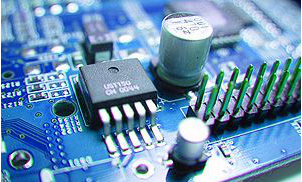The production principle of PCB board
1. Print the circuit board. Print out the drawn circuit board with transfer paper, pay attention to the slippery side facing you, generally print two circuit boards, that is, print two circuit boards on one sheet of paper. Select the printed circuit board.
2. Cut the copper clad laminate, and use the photosensitive board to make the whole process diagram of the circuit board. Copper clad laminate, that is, a circuit board covered with copper film on both sides, cut the copper clad laminate to the size of the circuit board, not too large to save materials.
3. Pretreatment of copper clad laminate. Use fine sandpaper to polish off the oxide layer on the surface of the copper clad laminate to ensure that the carbon powder on the thermal transfer paper can be firmly printed on the copper clad laminate when transferring the circuit board. The standard for polishing is that the surface of the board is bright without obvious Stains.
4. Transfer circuit board. Cut the printed circuit board to a suitable size, stick the printed circuit board on the copper clad laminate, put the copper clad laminate into the heat transfer machine after alignment, and make sure that the transfer paper is not misaligned when placing it. Generally speaking, after 2-3 transfers, the circuit board can be transferred firmly on the copper clad laminate.

The heat transfer machine has been preheated in advance, and the temperature is set at 160-200 degrees Celsius. Due to the high temperature, pay attention to safety during operation!
5. Corrosion circuit board, reflow soldering machine. First check whether the printed circuit board is completely transferred. If there are a few areas that have not been transferred well, you can use a black oil-based pen to repair it. Then it can be corroded. When the exposed copper film on the circuit board is completely corroded, the circuit board is removed from the corrosive solution and cleaned, so that a circuit board is corroded.
The composition of the corrosive solution is concentrated hydrochloric acid, concentrated hydrogen peroxide, and water in a ratio of 1:2:3. When preparing the corrosive solution, discharge water first, and then add concentrated hydrochloric acid and concentrated hydrogen peroxide. Be careful of splashing on the skin or clothing, and wash it in time. As a strong corrosive solution is used, pay attention to safety during operation!
6. Circuit board drilling. The circuit board needs to be inserted with electronic components, so it is necessary to drill the circuit board. Choose different drill pins according to the thickness of the electronic component pins. When using the drill to drill, the circuit board must be pressed firmly. The drill speed cannot be too slow. Please carefully watch the operator's operation.
7. Circuit board pretreatment. After drilling, use fine sandpaper to polish off the toner on the circuit board, and clean the circuit board. After the water dries, apply rosin to the side with the circuit. In order to speed up the solidification of the rosin, we use a hot air blower to heat the circuit board, and the rosin can solidify in only 2-3 minutes.
8. Welding electronic components. After soldering the electronic components on the board, turn on the power. Electronics Co., Ltd. (Yusheng 13356471516) is an electronic equipment manufacturer integrating development, production and marketing. It specializes in the production of board splitters, PCB splitters, aluminum substrate splitters, curve splitters, and multi-knife splitters. Machine, light bar splitter, V-CUT splitter, knife splitter, LED splitter, guillotine splitter.
How about the material of the PCB board
1. The PCB does not move during the cutting process of the PCB splitter, and the circular knife slides to ensure that the electronic components of the substrate are not damaged due to movement.
2. The sliding speed of the round knife can be adjusted.
3. In response to the depth and wear of the V groove, the distance between the upper circular knife and the lower can be adjusted accurately.
4. It can solve the problem that the parts cross the V groove to realize the board separation.
5. Reduce the internal stress generated when cutting the board to avoid tin cracking.
6. The slitting speed is controlled by a knob, and the slitting stroke can be set freely and has an LCD display. PCB splitter plate knowledge and standards At present, there are several types of copper clad laminates widely used in China, and their characteristics are as follows: the types of copper clad laminates, the knowledge of copper clad laminates, and the classification methods of copper clad laminates. With the development and continuous progress of electronic technology, new requirements have been continuously put forward for printed circuit board substrate materials, thereby promoting the continuous development of copper clad laminate standards.
At present, the main standards for substrate materials are as follows: 1. Standard: China's standards for substrate materials include GB/T4721-47221992 and GB4723-4725-1992. The copper clad laminate standard in China is the CNS standard, which is based on the Japanese JIs standard. Developed and released in 1983.
2. International standards: Japanese JIS standards, American ASTM, NEMA, MIL, IPc, ANSI, UL standards, British Bs standards, German DIN and VDE standards, French NFC and UTE standards, Canadian CSA standards, and AS Standards, FOCT standards of the former Soviet Union, international IEC standards, etc.